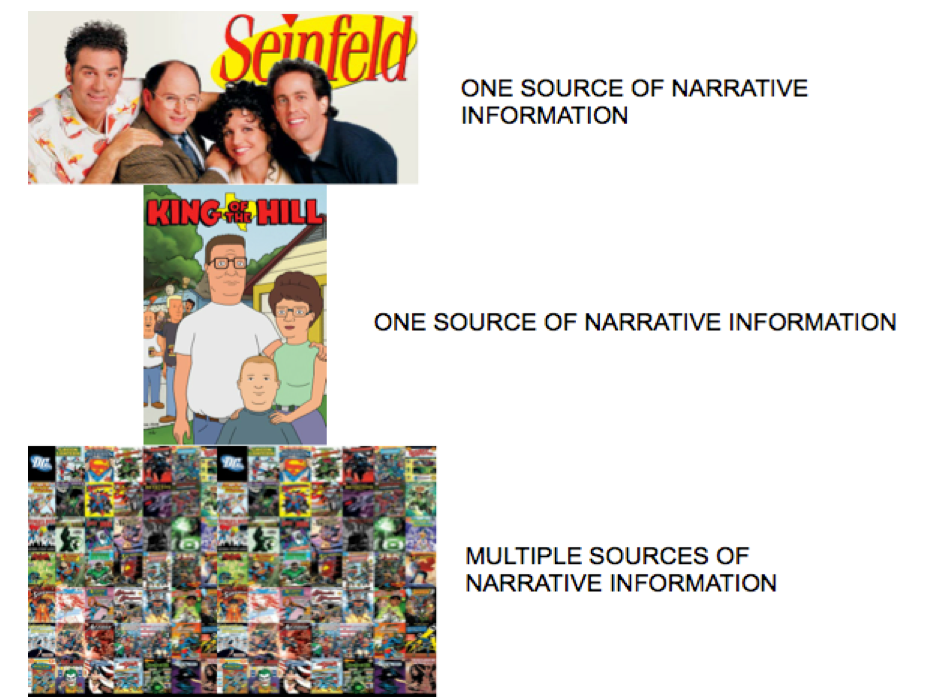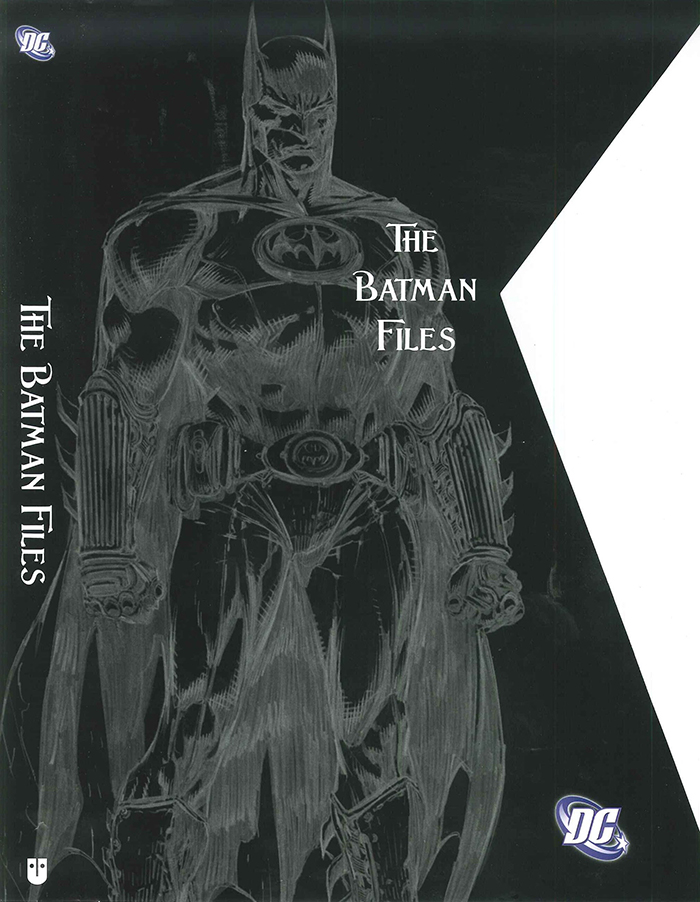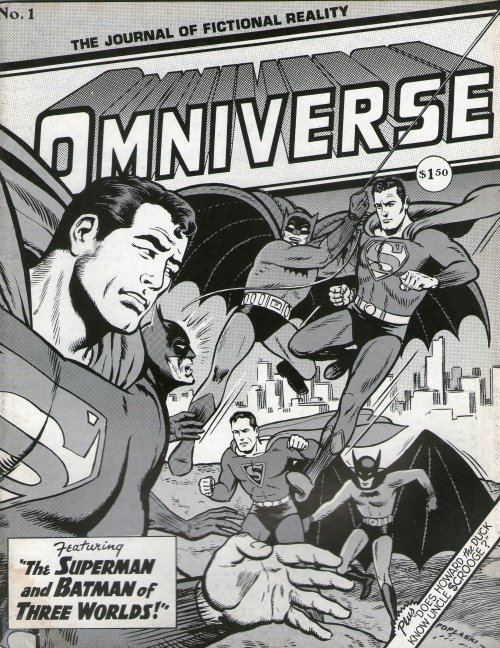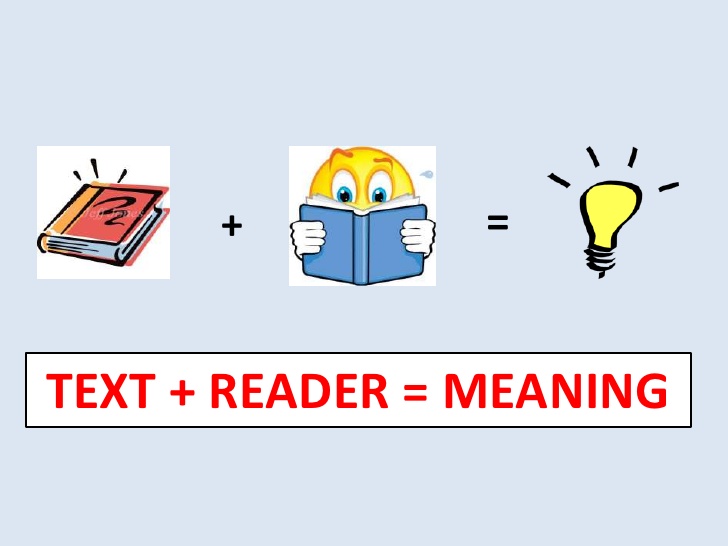…continued from Batman and the Art of Continuity Maintenance
_______________________________
_______________________________________________________________________________________
_______________________________
A BRIEF HISTORY OF CANON
Understanding fictional canon will help us understand the whys, whats, and hows of the Batman Chronology Project. But before jumping in headlong, let’s review the history of the concept of canon in general. The term canon originally derives from the authentication of religious scripture. Ancient texts like The Bible, Gospels, The Tanakh, The Midrash, The Talmud, Sūtras, Pitakas, The Daozang, and The Tantras have multiple volumes or interpretations created by multiple authors in a similar way that most fairy tales, folklores, folk tales, and mythologies do. (Whether or not most religious institutions will admit to that is another thing all together.) All of these sacred stories, from the Old Testament to King Arthur and the Knights of the Round Table, deal with the conundrum of legitimizing a single official narrative while having varied accounts or versions, either because of multiple authorship or a lengthy oral tradition.
Outside of a religious context, canon can also be defined as “a body of historical works in music/visual art/film/literature considered to be masterpieces worthy of study” (Frank Kermode, Continuities). A problem with this form of canon lies in the question: “Who determines what is deemed worthy?” Typically capitalist enterprises aimed solely at the commodification of art, canons have been determined by a White male majority of intellectuals and critics. Only in more recent years has the canon begrudgingly begun to accept other works of non-White, non-colonial, or non-male authorship i.e. diverse works. But in any case, this type of canon is outdated and old-fashioned, even in most legitimate circles of academia. Over time, the traditional forms of canon have given way to a more contemporary (and interesting) version—fictional canon, the very driver of the Batman Chronology Project’s methodology.
Fictional canon was invented by Ronald Knox in 1911 in reference to Arthur Conan Doyle’s Sherlock Holmes. There were a ton of Sherlock knock-offs, so Knox used canon to deem which books fit into the official Holmes-verse and which were mere imitations. (Sherlock Holmes is actually a complicated example to talk about in regard to canon since the character is now in the public domain and has been re-created in various media formats and even since been included into the same world as Batman and Superman. Public domain is another great topic of discussion. Warner Bros Discovery and Disney are great at lobbying Congress and putting out material simply to extend copyright—the very reason some hundred-year-old characters haven’t gone into public domain even though they should have by now.)
The concept of fictional canon that was first used to categorize Sherlock Holmes was then later applied to the world of superheroes in the 1950s as shared fictive universes came to prominence alongside multiverse storytelling. By the 1970s, some folks at both Marvel and DC were using the term canon internally (as were some comic book fans) to differentiate between stories that fit into continuity versus those which did not. Fictional canon garnered further definition and academic exploration in Mark Gruenwald and Dean Mullaney’s Omniverse (1977-1979), a groundbreaking two-issue journal/fanzine wherein which comic book cenacles waxed philosophic about world-building and the “physics” of fictive superhero realities. Notably, it was the late great Gruenwald, a longtime Marvel editor, who first coined the term “omniverse” in the mid 1970s. The contemporary evolution of Gruenwald and Mullaney’s fictional canon is the focus of the Batman Chronology Project, and we’ll begin a didactic examination of this type of canon now.
WHAT COUNTS AS CANON?
Today, fictional canon refers to any source material in serialized media that is in-continuity as opposed to what is out-of-continuity or, in other words, what officially “counts” toward story and character development versus what “doesn’t count.” At first glance, this seems to be a very scientifically precise concept, with canon operating more-or-less as the opposite of fan-fiction, and with every story categorized as either canon or non-canon (as generally determined by the authors and owners of said conceptual material). However, this is a gross oversimplification. Because serialized media can involve multiple interwoven stories by multiple creators, much of what goes into making sense of the narrative is done solely in the mind of the reader. As such, canon, while ostensibly chained to the rigidity of authorship and ownership, isn’t really doctrinaire at all.
In fact, most canons exist only because they have been accepted as “official” by a fan base. This is partly because canon is linked to reader-response criticism i.e. engagement with a subject material where “interpretive communities of fans determine true narrative.” In 1968, semiotician Roland Barthes penned the essay “The Death of the Author,” in which he theorized that an individual reader’s interpretation of a fictive text carries more weight than any meaning intended by the author. Barthes’ dialectical structuralist contemporaries—such as Julia Kristeva, Michel Foucault, Jacques Lacan, Umberto Eco, and Jacques Derrida—would echo this idea throughout the 1960s, 1970s, and 1980s. Kristeva and Lacan wrote often of the illusory or contradictory nature of textual meaning. Heavily influenced by Barthes and company, reader-response theorists Wolfgang Iser, Stanley Fish, Norman Holland, Louise Rosenblatt, and Gérard Genette also spent a bulk of their 20th century careers wielding a Derridean il n’y a pas de hors-texte philosophy to explain how texts control reader response(s) while simultaneously containing “gaps” that the reader creatively fills. Genette specifically coined the term paratext to describe the external elements of a narrative that are interpreted by reader. Because serialized superhero stories contains a lot of paratext, they cultivate a transtextual meta-semiotic system, providing what scholar Martin Baker calls “authorial guidance, instructions, and injunctions” to its readership. In his book Story Logic (2002), David Herman details how all audiences “engage in a temporal ordering of events” as they interact with media. As William Proctor postulates in Reboot Culture (2023), canon has a transfictional quality where “each instantiation [of canon] carries a unique narrative signature that indicates what continuity protocols should be followed when fan audiences approach a text.” Furthermore, as Proctor and fellow media professor Henry Jenkins illustrate, by engaging with the primary text, fans learn or “are expected to know which interpretive frame should be applied to any given title.” Resonating here is the concept of hyperdiegesis, described by author Matt Hills as the process by which readers (as they consume a singular version of a text) consciously and subconsciously create unique sub-narrative according to principles of internal logic and extension derived from within said text.
The delightful TV Tropes website emphasizes transfictionality, and paratextuality, citing how canon is determined by reader-response and good ol’ fandom: “Canons for completed works with a single author or finite group of authors are descriptive, whereas fans’ attempts to define canon for ongoing works are prescriptive. If a fact is ‘canon,’ you are ‘not allowed’ to contradict it.” Basically, the word descriptive refers to rules predicated upon information given by the author(s). Conversely, the word prescriptive refers to rules that reflect reader value judgments or opinions. (This is obviously a rigid definition, but it helps us comprehend the intertextual/syntagmatic relationship between canon and fandom.) TV Tropes reiterates the idea of canon being malleable in the hands of the fans, commenting, “In fan communities ‘canon’ can sometimes boil down to ‘the bits we like.’ Fans will attempt to find any excuse to ‘de-canonize’ facts that they personally find inconvenient.” Proctor, citing Allan Cameron’s Modular Narratives in Contemporary Cinema (2008), addresses the paradoxical malleability of canon, citing that its borders are trans-linear—“impermeable and porous, water tight and leaky, situated ‘between linearity and non-linearity,’ ‘temporal anchoring and temporal drift, simultaneity and succession, chaos and order.'” In his article “A Sort of Homecoming: Fan Viewing and Symbolic Pilgrimage” (2005), critic Will Brooker aptly distinguishes the interconnection between comic fandom and authorship as “twin siblings locked into a relationship of debate and mutual dependence.”
Regarding who has the right to superintend canon, columnist Travis Hedge Coke goes the distance, saying, “There is no canon. [Readers and fans] can, and have, ordered certain comics into several different, sometimes overlapping canons. Further, belonging to a canon does not ensure that works are aligned by a shared chronology or continuity. Canons are personally established, or they are established for business reasons, for marketing purposes, and that’s about it. It’s not a magic thing, it only means, at essence, ‘these works count towards…’ whatever you want them to count towards. Canon is not a judgment of total value or relevance to all things. And canons are rarely permanent, both the personal and the business sorts.” (This is the very essence of what is commonly known as headcanon, which is roughly defined as an individual fan’s personal interpretation of continuity.) Since the underlying rationalism of canon is rooted in fandom and fan interaction with the stories, there’s no real way of determining what is officially canon or non-canon—no hard line singular definition to draw upon. Ironically, it is because of this that canon and fan-fiction are both rooted in fandom. Therefore, in many ways, canon is an irresolvable dilemma, a pliant construct that can never be 100% finite. Yet, this is the very reason I do what I do with the Batman Chronology Project! In trying to bring order to the orderless, I’ve come to define canon as: The collaborative perception of a work by both authors and readers, through which the story MAKES THE MOST NARRATIVE SENSE.
CANON IN THE FACE OF COMPLEXITY
Now that we know what fictional canon is and how it functions, let’s apply what we’ve learned directly to superhero timeline-construction. Unlike classics like Sherlock Holmes or old pulp stories like Tarzan or Doc Savage, which were primarily penned by single authors, contemporary superhero comics are written by a plethora of authors and are spread throughout multiple sources (or streams) of ongoing narrative. Tracking continuity architecture that has multiple streams of narrative continuity is much harder than tracking a single stream. And the chance of continuity error (plot hole, narrative contradiction, intradiegetic anomaly, etc…) only increases as you add more time and more streams of information. In Captain America and the Nationalist Superhero (2013), Jason Dittmer discusses this very phenomenon, stating that “an exponentially expanding set of narrative elements composed by countless authors” leads to the “illusion of consistency and singularity.” Take something that has a ton of material—say, TV shows like King of the Hill, Law & Order, Seinfeld, or Full House. Each of these shows has a lot of episodes to sit through to complete the whole picture, but each contains only one single primary source of information (i.e. one weekly episodic format, written by more-or-less the same creative team, with a finite beginning and end). It may take a while, but the episodes are in order and all you have to do is watch them to get the chronological tale in full. With superhero comic universes, on the other hand, you have to sort through multiple sources of narrative information (i.e. various weekly release titles, written by ever-shifting creative teams, with a basically never-ending story).

Complexity increases with each additional source of narrative information.
Superhero comics get even wilder vis-à-vis multiple sources of narrative information when we think of the synergistic trans-media experience that permeates most storytelling today. It’s not just different narratives from comic books. What about board games, toys, TV shows, video games, phone apps, novelizations, etc…? Where, when, and how do they fit in? Speaking about the effect of trans-fictionality across different platforms, Proctor highlights that superheroes are “developed and transformed through dialogic process, soaking up the overspill of textual fluids from their various and inconsistent trans-media adventures.” The impact of trans-media upon canon is not only a subject of much debate, but it’s one that also clearly complicates matters further.
Yet even more complications arise due to the fact that each superhero company places their intellectual property within the spectrum of a shared world—a universe or multiverse. While all of Sherlock Holmes’ adventures occur on a singular timeline in which he, Watson, and Moriarty all existed, the same can be said of Spider-Man, Iron Man, and Captain America, who all exist in the Marvel Universe. Or the characters of the Marvel Cinematic Universe. Or Luke, Leia, and Han Solo in the Star Wars Universe. Likewise, Batman, Superman, and Wonder Woman all exist in the DC Universe. There is so much going on and so much room for contradiction when working within the confines of a cluttered fictional world, especially one in which there are hundreds of toys in the sandbox, so to speak. Therein lies another part of the problem. To put it bluntly, not only are there are a lot of characters to keep tabs on, there are a lot of creators to keep tabs on as well! After all, each creator brings something different to the table. As the old saying goes, “Too many cooks in the kitchen spoil the broth”—or even more applicable, “A camel is a racehorse designed by committee.” Superhero comics are a monster-camel with a billion humps. We’ve already mentioned that the concept of fictional canon derives from religious scripture-building, so it should come as no surprise that these monster-camel cooks sometimes utilize master narrative-thread guides, commonly known in the biz as “story bibles,” when trying to keep their messy multi-faceted fictive worlds straight.
Writers and editors also break their own “rules” with ad hoc retcons—RETtroactive CONtinuity changes that specifically contradict prior established narrative history. (The first use of the term “retcon” can be attributed to fans discussing storylines in the letters section of All-Star Squadron in 1983.) TV Tropes notes how various writers often “can tweak continuity quite a lot without actually breaking it by using [various methods, including retcons].” The implication here is that, just because a story can still be understood, it doesn’t mean the story hasn’t been bent to just before its breaking point by competing creators. As critic Mark Mitchell says, “Usually retcons happen with shifts in creative teams, character relaunches, or when reaching back deep into a line’s history to incorporate some historical element that doesn’t quite fit in the modern landscape.” There are often many retcons in superhero comics, making it hard to arrive at firm conclusions. In fact, it is because of this revisionism that many canonical Batman stories become essentially interchangeable on a timeline. To sum up, the percentage of narrative certainty decreases when you add authors, time, sheer weight of published material, complexity of shared worlds, characters, information sources, and the hot-blooded opinions of fans. Classicist Nick Lowe speaks truth when he describes superhero comics as “the largest narrative constructions in human history—exceeding, for example, the vast body of myth, legend, and story that underlies Greek and Latin literature.”

The Batman Files by Matthew Manning (2011)
In 2011, just as DC was regenerating its line yet again, they joined forces with Lionheart Books to publish author Matthew Manning’s grand opus, a tribute to the detailed history of Modern Age Batman, entitled The Batman Files. In this tome, Manning says, “Every story counts. It’s a pretty simple viewpoint, but in [regard to codifying a Batman timeline], there have been so many stories, so many interpretations, most people find it necessary to ignore particular tales. After all, if a story doesn’t match up to your tastes or views, then it’s that much easier to act like it never happened. But the catch is, it did… If you’re new to the Batman mythos, I encourage you to seek out the original [comics]. While you are sure to find contradictions and elements that refuse to work in tandem with one another, you’ll also be in for some of the most entertaining hours of your life, brought to you by some of the most creative and talented storytellers of any medium… [If you don’t like a certain Batman timeline], feel free to ignore it in favor of your own particular brand of continuity. But it still counts just the same.” This refreshing postscript couldn’t be more germane to the modus operandi of the Batman Chronology Project. Despite the irreducible messiness of serialized superhero comic narrative, once you understand how canon works, you can figure out canon itself. Returning to Proctor, “There is no such thing as a ‘perfect’ continuity system,” he opines. “Stable, coherent, and consistent diegetic foundation can never be attained.” As the marvelous Frances Yates says, “[A historical account] will not be a perfect structure. It will be a temporary, even a makeshift, edifice, which later architects will no doubt revise and alter. Nevertheless, even a temporary structure is better than no structure at all.” This quote refers to the study of arcane history, but it easily applies to canon-building as well. My business isn’t about finding a perfect structure—it’s wading through all the above information to create the best possible canon.
_______________________________
_______________________________________________________________________________________
_______________________________
In order to move forward and conjure up the best chronology, one must first have a comprehension of DC’s reboots. Please click on the following link to continue reading the next part: Relaunched, Rebooted, and Bewildered
_______________________________
_______________________________________________________________________________________
_______________________________






The best possible canon? my good sir, your way of making canon is to conglomerate what Y0U THINK should be canon, and making a timeline of it because YOU dont like what DC DOES with its characters. And while i too don’t necessarily like or love what the writers and artists choose to do with their own creations, we as fans must take that and go with it. YOUR timelines are your way of couping with the chaos of DC. I UNDERSTAND. But telling people on a page you create for entertainment that it is the TRUTH is wrong. You know as well as I that unless DC says its canon to a major current arc or story, it’s not. so remember that when you type your timelines. thank you
Death of the Author. Birth of the Reader. ‘Nuff said.
Copium and word salad.
What is the author coping with exactly here?
As for ‘word salad’…guess you can’t read more than a paragraph a day?
coping with the fact that true canon doesn’t exist in DC (at least not in the form OP is trying to make it exist) and word salad because this entire page could have actually been summed up in one paragraph ironically enough
Ignore the two doofuses above me. Excellent write-up 🙂
This is much appreciated, R.G.! Barthes is definitely a major influence here, although I’ve hesitated including actual Barthes quotations in this piece so as to not make it too obvious. However, taking inspiration from you, I think I might change that! Thanks again.